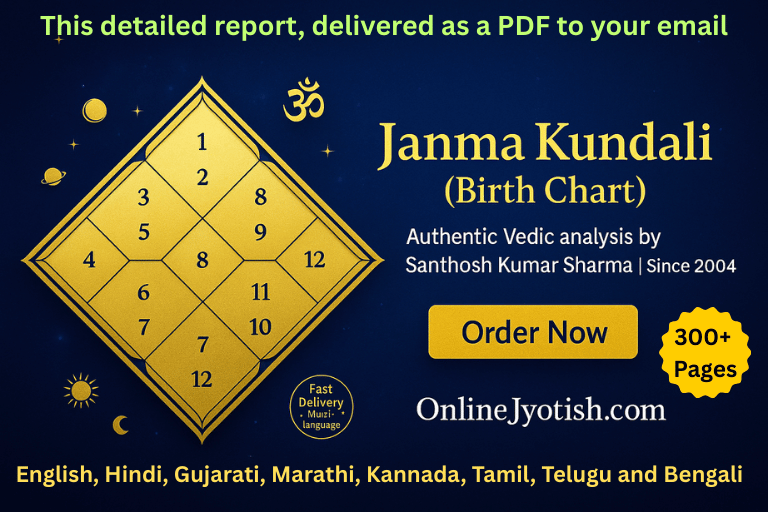Get the essential Panchang details for your daily pujas, vratas, and sankalp. Easily find Tithi, Nakshatra, Yoga, Karana, Varjyam, Rahu Kalam, and auspicious timings to start any task successfully.
Our specialty is accurate and scientific Drigganita (Drik) Panchang for any location and date. See the full list of features below.
Get Panchangam for Your Location
Select your location and the desired date to generate a detailed Panchangam report.
Complete Details Provided by Our Online Panchangam
Our free English Panchangam provides the following comprehensive and accurate information for each day:
-
Primary Panchangam Details:
- Sunrise/Sunset (Sun & Moon), Samvatsara, Ayanam, Ritu, Masam, Paksham.
- Tithi, Varam, Nakshatram, Yogam, Karanam with ending times.
- Udaya Tithi for Sankalpam, and Shraddha Tithi for Shraddham.
-
Auspicious and Inauspicious Timings:
- Amrita Ghadi, Rahu Kalam, Gulika Kalam, Yamaganda Kalam.
- Durmuhurtam, Varjyam, and other important timings.
-
Daily Muhurtams & Time Divisions:
- Day/Night Divisions: Arunodayam, Pratah-kalam, Sangava-kalam, Madhyahnam, Aparahnam, Sayamkalam, Pradosha-kalam, Nishitha-kalam.
- Auspicious Muhurtams: Brahma Muhurtam, Vijaya Muhurtam, Abhijit Kalam, Godhuli Muhurtam.
- Trisandhya Timings: Morning, afternoon, evening Sandhya timings.
- Gowri Panchangam, Choghadiya, Hora timings, and Dina Muhurtams.
-
Analysis and Other Details:
- Pujas & Homas: Agni Vas, Shiva Vas, and Homahuti timings.
- Travel Suggestions: Disha Shool and remedies.
- Tarabalam/Chandrabalam: Daily lookups.
- Planetary Positions: Rasi and Nakshatra positions at sunrise.
-
Lagna-Related Analysis:
- Daily Lagnantya table (ending times).
- Lagna Shubhamsa, Pushkaramsa, auspicious Lagna timings.

Your Divine Answer is Just a Moment Away
Calm your mind and focus on a single, clear question you wish to ask the cosmos. When you are ready, press the button below.
Get Your Answer NowFree Astrology
 Hindu Jyotish App. Multilingual Android App. Available in 10 languages.
Hindu Jyotish App. Multilingual Android App. Available in 10 languages.Free Daily panchang with day guide
 Are you searching for a detailed Panchang or a daily guide with good and bad timings, do's, and don'ts? Our daily Panchang service is just what you need! Get extensive details such as Rahu Kaal, Gulika Kaal, Yamaganda Kaal, Choghadiya times, day divisions, Hora times, Lagna times, and Shubha, Ashubha, and Pushkaramsha times. You will also find information on Tarabalam, Chandrabalam, Ghata day, daily Puja/Havan details, journey guides, and much more.
Are you searching for a detailed Panchang or a daily guide with good and bad timings, do's, and don'ts? Our daily Panchang service is just what you need! Get extensive details such as Rahu Kaal, Gulika Kaal, Yamaganda Kaal, Choghadiya times, day divisions, Hora times, Lagna times, and Shubha, Ashubha, and Pushkaramsha times. You will also find information on Tarabalam, Chandrabalam, Ghata day, daily Puja/Havan details, journey guides, and much more.
This Panchang service is offered in 10 languages. Click on the names of the languages below to view the Panchang in your preferred language.
English,
Hindi,
Marathi,
Telugu,
Bengali,
Gujarati,
Tamil,
Malayalam,
Punjabi,
Kannada,
French,
Russian,
German, and
Japanese.
Click on the desired language name to get your free Daily Panchang.
Marriage Matching with date of birth
 If you're searching for your ideal life partner and struggling to decide who is truly compatible for a happy and harmonious life, let Vedic Astrology guide you. Before making one of life's biggest decisions, explore our free marriage matching service available at onlinejyotish.com to help you find the perfect match. We have developed free online marriage matching software in
Telugu,
English,
Hindi,
Kannada,
Marathi,
Bengali,
Gujarati,
Punjabi,
Tamil,
Malayalam,
Français,
Русский,
Deutsch, and
Japanese
. Click on the desired language to know who is your perfect life partner.
If you're searching for your ideal life partner and struggling to decide who is truly compatible for a happy and harmonious life, let Vedic Astrology guide you. Before making one of life's biggest decisions, explore our free marriage matching service available at onlinejyotish.com to help you find the perfect match. We have developed free online marriage matching software in
Telugu,
English,
Hindi,
Kannada,
Marathi,
Bengali,
Gujarati,
Punjabi,
Tamil,
Malayalam,
Français,
Русский,
Deutsch, and
Japanese
. Click on the desired language to know who is your perfect life partner.
Random Articles
- 29 मार्च 2025: आंशिक सूर्यग्रहण - समय और ज्योतिषीय प्रभाव
- 22 सितंबर, 2025 का आंशिक सूर्य ग्रहण: शहर, समय और ज्योतिषीय जानकारी
- Understanding the Effects of Ketu
- Sun-Jupiter Conjunction in Vedic Astrology
- Sagittarius (Dhanu) Moon Sign Details
- దుర్గాష్టమి 2025: ప్రాముఖ్యత, పూజా విధానం, కన్యా పూజ & ఉపవాసం


